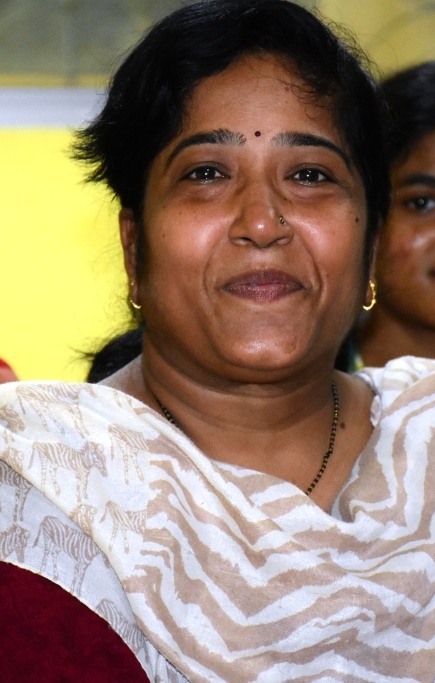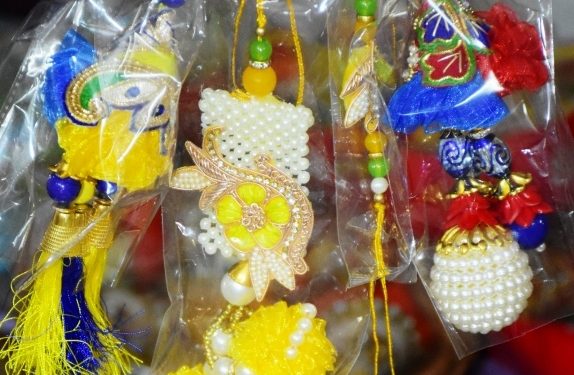Cuttack, August 25: The much-awaited Raksha Bandhan is here and almost every Rakhi shop is witnessing serpentine queues.
An integral part of Indian culture, the festival cherishes the bond between brothers and sisters, especially for the Marwari community, where there is a tradition of tying a Rakhi to one’s sister-in-law as well.
Chanda Dengla, a professional Rakhi maker, has been making Marwari Rakhis for the past fifteen years.
Orissa POST interacted with Chanda to know more about the Marwari Rakhi making and how she has carved a niche for herself in hand-made Rakhi industry.
“Among us Marwaris, as well as in some parts of northern India there is a tradition of tying Rakhis to brothers as well as sisters-in-law colloquially known as Bhabi,” she said. Banking on the tradition, the 48-year-old entrepreneur took a leap of faith and ventured into the business.

“It was in 2003, that I started making Joda Rakhis, Joda meaning pair. One is for your blood brother while another one called Lumba is for your Bhabi,” she added.
These forms of Rakhi are mostly seen in the hands of Rajasthani women, where they wear Lumbas along with colourful bangles.
“Lumbas are tied to the wedding bangles or Sankhas as they are commonly known,” she pointed out.
The Lumba Rakhis are made with pearls, silk threads, artificial flowers and colourful stickers. During the Rakhi season, when the demand is at the peak I have to make around 8,000 pieces, she mentioned.
It may be mentioned here that Chanda has been supplying Rakhis to many shops in the twin cities of Bhubaneswar and Cuttack moreover she jointly owns a shop with her husband at Dolamundai in Cuttack.
Detailing the materials required for Lumba Rakhi, she said, “It’s simple and easy. I use thick papers, Mauli thread, glue, stone chain, Kundan, pearls, Latkan, silk thread and artificial flowers.”
Chanda highlighted that she took around 20 minutes to make one such Rakhi and in a day she can “comfortably make 30 such Rakhis.”
Chanda, a proponent of self-reliance among women, has employed eight women and has been imparting training to them for the past many years.
“Whatever I have done, that might be a drop in the ocean but otherwise the ocean would have been a drop less, wouldn’t it,” a gleeful Chanda said. Currently, she has 2,000 Rakhis ready to be sold.
Chanda who comes from a Rajasthani Marwari family, has the old-age tradition of Lumba Rakhi-making for generations.
“It may be our Bhabis or Bhaiyas (brother-in-law), all are tied with homemade Rakhis, it was never a commercial venture for us, though we are Marwaris,” a chuckling Chanda said.
After marriage, Chanda tried her hands on Rakhi-making to see if she still has the dexterity intact in her hands but little did she know what started as a hobby would catapult her to fame.
Her popularity is testified by the fact that in 2017, Kalinga Institute of Social Sciences (KISS) in Bhubaneswar had invited her to showcase the art of Lumba Rakhi to its 2,000 students. “However, due to some personal problems I couldn’t be there,” she said.
Cuttack which has a large Marwari population is a major market for Chanda who has always received words of encouragement from her husband. “He has always been a source of motivation for me, I can’t say that he plays second fiddle, I would say that he leads me,” she added.
Story behind Lumba Rakhi: According to stories and tradition, in Marwari community, a sister-in-law is an integral part of the family. Therefore on Rakhi, in order to strengthen the relationship with the Bhabi or sister-in-law, her sisters-in-law, colloquially known as Nanands tie her a Lumba, which means bangle in Marwari.
CHAITALI SHOME, OP







































